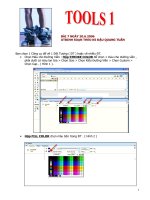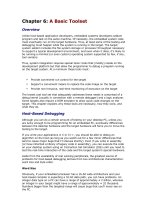DEVELOPING TOOLS
Bạn đang xem bản rút gọn của tài liệu. Xem và tải ngay bản đầy đủ của tài liệu tại đây (95 KB, 9 trang )
CHAPTER 2 DEVELOPING TOOLS
2.1 DATABASE MANAGEMENT SYSTEM (DBMS)
2.1.1 Kinds of DBMS
There are many different types of DBMS, ranging from small systems that run on personal
computers to huge systems that run on mainframes. Now we will introduce some types of
DBMS before choose one: Oracle, SQL, Access, MySql etc.
Oracle
Oracle is a relational database system from Oracle corporation extensively used in product
and internet-based applications in different platforms. Oracle is a powerful relational
database management system that offers a large feature set. Along with Microsoft SQL
Server, Oracle is widely regarded as one of the two most popular full-featured database
systems today. Oracle is only used for databases with huge size, from millions to tens of
millions records. This DBMS runs based on Client/Server model, can adopt different
operating systems and security level. Because of complexity of database so disadvantages
of Oracle are high cost of maintaining database and training IT staff.
Microsoft Access
Microsoft Access is a relational database running under Microsoft Windows. Access is the
desktop database included in Microsoft’s popular productivity suite Microsoft Office. The
product may connect with many different databases, but it is shipped with the Microsoft
JET Engine, and in this paper the two terms are synonymous, unless otherwise noted. The
inclusion of Access in the MS Office Suite enables MS Office users to create simple
database applications very inexpensively. The arguments for using MS Access are very
strong because of its low cost and its backward compatibility. Access also uses very few
resources and is easily distributed, since the application and data can be stored in a single
file. However, popularity does not always translate into successful applications. Access
applications typically start as a single-user application created by the user for his or her
specific use. But, many times another individual in the organization sees value in the
application and the application is then shared. This sharing can proliferate to the point
where a single Access application, designed for one user, is servicing multiple users,
something normally handled by a full server-based database management system. With
more than one person using the application, the data storage requirements also increase.
These increases can quickly eclipse the limits Access imposes. Growth in either the user
count or data storage eventually leads to degradation in performance and stability.
Corruption also occurs at a much higher rate in Access than in server-based database
management systems. In a server-based system, only the database server engine itself
accesses the file, while in a file sharing system like Access, all users have access to the file.
This multiple and unmanaged access is the most common cause of data corruption in an
Access data file. Though all database systems face some risk of corruption, the possibility is
exponentially higher in Access, because the architecture is built on file sharing.
Microsoft SQL Server
SQL Server 2000 is a relational database management system (RDBMS) using
Transact_SQL to exchange information between Client computer and SQL Server
computer. A RDBMS consists of databases, database engine and applications that use to
manage data. SQL Server 2000 can integrate in harmony with other servers such as Internet
Information Services (IIS), E-Commerce Server, Proxy Server, etc.
Although SQL Server 2000 is designed to work as the data storage engine for thousands of
concurrent users who connect over a network, it is also capable of working as a stand-alone
database directly on the same computer as an application. The scalability and ease-of-use
features of SQL Server 2000 allow it to work efficiently on a single computer without
consuming too many resources or requiring administrative work by the stand-alone user.
The same features allow SQL Server 2000 to dynamically acquire the resources required to
support thousands of users, while minimizing database administration and tuning.
MYSQL
MySQL, the most popular Open Source SQL database management system, is developed,
distributed, and supported by MySQL AB company, it’s also a relational database
management system. MySQL software is Open Source means it is possible for anyone to
use and modify the software. Anybody can download the MySQL software from the
Internet and use it without paying anything. The MySQL Database Server is very fast,
reliable, and easy to use. MySQL Server also has a practical set of features developed in
close cooperation with our users. MySQL Server was originally developed to handle large
databases much faster than existing solutions and has been successfully used in highly
demanding production environments for several years. Though under constant
development, MySQL Server today offers a rich and useful set of functions. Its
connectivity, speed, and security make MySQL Server highly suited for accessing databases
on the Internet. The MySQL Database Software is a client/server system that consists of a
multi-threaded SQL server that supports different backends, several different client
programs and libraries, administrative tools, and a wide range of application programming
interfaces (APIs).
2.1.2 Choose DBMS and explain reasons
Choosing DBMS is a very important decision, it should base on different factors such as
infrastructure, human resource, volume of information etc. The Knowledge Base System is
designed for students and lecturers of the Faculty of Informatics and Economic in
information exchanging, thus size of database is not over large. With current infrastructure,
MSSQL Server is a suitable choice along with many benefits:
Utilizing existing infrastructure
MS SQL Server is easy-to-use and has user friendly interface
Low overhead
Integrated with Microsoft IIS
MS SQL Server is a perfect DBMS, provides a new generation of features and functions,
including many strong tools for managing and controlling database. Microsoft SQL Server
2000 features include:
Internet Integration.
The SQL Server 2000 database engine includes integrated XML support. It also has the
scalability, availability, and security features required to operate as the data storage
component of the largest Web sites. The SQL Server 2000 programming model is
integrated with the Windows DNA architecture for developing Web applications, and SQL
Server 2000 supports features such as English Query and the Microsoft Search Service to
incorporate user-friendly queries and powerful search capabilities in Web applications.
Scalability and Availability.
The same database engine can be used across platforms ranging from laptop computers
running Microsoft Windows® 98 through large, multiprocessor servers running Microsoft
Windows 2000 Data Center Edition. SQL Server 2000 Enterprise Edition supports features
such as federated servers, indexed views, and large memory support that allow it to scale to
the performance levels required by the largest Web sites.
Enterprise-Level Database Features.
The SQL Server 2000 relational database engine supports the features required to support
demanding data processing environments. The database engine protects data integrity while
minimizing the overhead of managing thousands of users concurrently modifying the
database. SQL Server 2000 distributed queries allow you to reference data from multiple
sources as if it were a part of a SQL Server 2000 database, while at the same time, the
distributed transaction support protects the integrity of any updates of the distributed data.
Replication allows you to also maintain multiple copies of data, while ensuring that the
separate copies remain synchronized. You can replicate a set of data to multiple, mobile,
disconnected users, have them work autonomously, and then merge their modifications
back to the publisher.
Ease of installation, deployment, and use.
SQL Server 2000 includes a set of administrative and development tools that improve upon
the process of installing, deploying, managing, and using SQL Server across several sites.
SQL Server 2000 also supports a standards-based programming model integrated with the
Windows DNA, making the use of SQL Server databases and data warehouses a seamless
part of building powerful and scalable systems. These features allow you to rapidly deliver
SQL Server applications that customers can implement with a minimum of installation and
administrative overhead.
Data warehousing.
SQL Server 2000 includes tools for extracting and analyzing summary data for online
analytical processing. SQL Server also includes tools for visually designing databases and
analyzing data using English-based questions.
In addition, Microsoft SQL Server 2000 extends the performance, reliability, quality, and
ease-of-use of Microsoft SQL Server version 7.0. Microsoft SQL Server 2000 includes
several new features that make it an excellent database platform for large-scale online
transactional processing (OLTP), data warehousing, and e-commerce applications.
The OLAP Services feature available in SQL Server version 7.0 is now called SQL Server
2000 Analysis Services. The term OLAP Services has been replaced with the term Analysis
Services. Analysis Services also includes a new data-mining component.
The Repository component available in SQL Server version 7.0 is now called Microsoft
SQL Server 2000 Meta Data Services. References to the component now use the term Meta
Data Services. The term repository is used only in reference to the repository engine within
Meta Data Services.
2.2 PROGRAMMING LANGUAGE (PL)
2.2.1 Kinds of Programming Languages
There are mainly 2 kinds of scripting on the Internet, client-side scripts that executes at the
users machine, and server-side. Server-side language is script/language, which runs on the
server and not the browser’s machine. Some of the more common languages are: PHP,
ASP, JSP and Perl. Each language is different - either slightly or completely, much like real
languages. Your choice of server-side language depends on what you want to do with the
script you are writing.
PHP
PHP (PHP Hypertext Preprocessor) is one of the most popular server-side scripting on web.
Server-side scripting is a web server technology in which a user's request is fulfilled by
running a script directly on the web server to generate dynamic HTML pages. It is usually
used to provide interactive web sites that interface to databases or other data stores. This is
different from client-side scripting where the viewing web browser, usually in JavaScript,
runs scripts. The primary advantage of server-side scripting is the ability to highly









